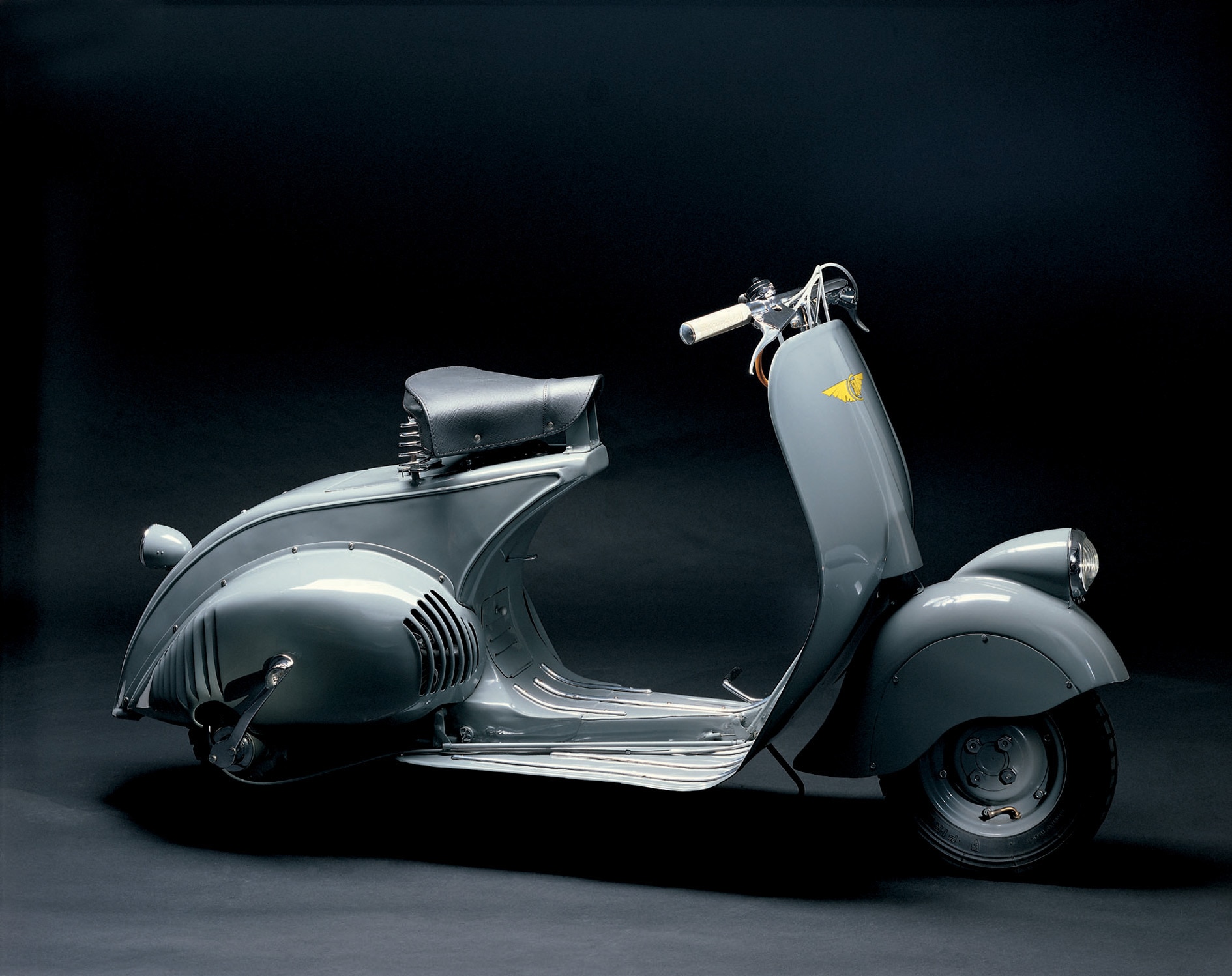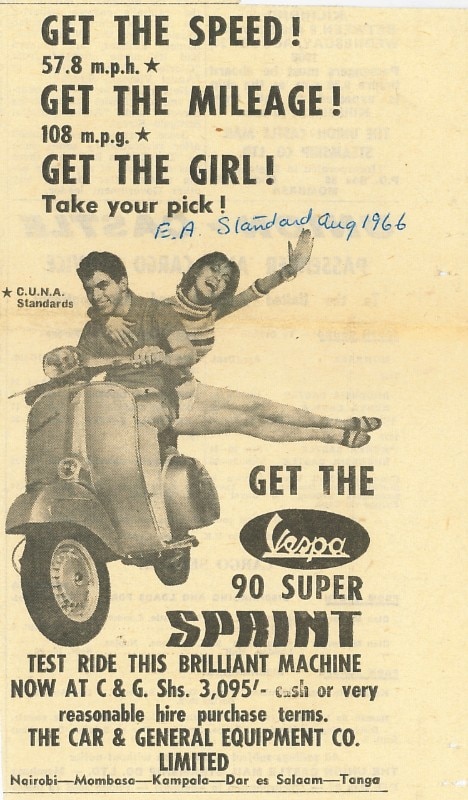Today, when we think of personal mobility vehicles, we think of electric scooters, Segways, folding bikes. But in 1946, it wasn’t like this. The king of micromobilty was the bike (or our own feet), and only a few people had the privilege of owning a motorcycle. However, in those times of difficulties, Italian motor vehicle manufacturer Piaggio decided to dare, by choosing Corradino d’Ascanio, an exceptional designer (we’ll get into that later) and counting on a hitherto-unseen vehicle: the Vespa.
The development of the Vespa wasn’t an easy one: the first prototype was the MP5 designed by Roberto Spolti, and to compare it with the Fiat Topolino (“Mickey Mouse”), it was christened “Paperino” (“Donald Duck”). It was beautiful, but it wasn’t right: it still looked too much like a motorcycle, and Enrico Piaggio had made it very clear: we needed something cheap, accessible to everyone and, most importantly, new. And then, came d’Ascanio. He was an engineer; he had worked in an aeronautic construction company (which he founded together with D’annunzio’s son) and he had designed the prototype of the first production helicopter. He was born in Popoli in 1891, and the biggest quirk of his character was that he didn’t like motorcycles. He didn’t use them, and most importantly he hated the fact that, in order to mount it, you had to “climb over it”. Long story short, he was the perfect person to design a motorcycle for those who didn’t like them.

 View gallery
View gallery
By applying his vast aeronautical knowledge, D'Ascanio found Columbus' egg. He invented the first load-bearing body motorcycle, which means that there wasn't any central tunnel you had to climb over. Mounting the Vespa was easy even when wearing a skirt or your good clothes, and you didn’t need to worry about getting your legs dirty, so you could use it in the city or in the countryside. The 98, the very first model of the Vespa was presented at the prestigious Golf Club di Roma in 1946. The Vespa 98 cost 55,000 lire, while the “luxury” version cost 61,000 lire. This was not cheap at all. At the time, the average salary was ten thousand lire, but the Vespa was what for us is a utilitarian: A necessity for which we are willing to get into debt. In fact, since there was a great demand, at the end of 1946 Piaggio decided to withdraw the economic model from the market, and only sell the most expensive one.

And the following year came the Corsa, the first race Vespa, which triumphed in the Monte Mario Hill Climb in Rome. The second series also had a spare wheel: given the bumpy the roads of that time it was a necessity, but it soon became a distinctive feature of the scooter. When the Vespa was first launched onto the market, it already was a cult. You had to wait months to finally get your hands on it, and the demand was so high, that black markets were selling it for three times the price. It's no coincidence that in 1947 its bitter enemy, the Lambretta, was also launched onto the market.

Vespa is a simple, malleable vehicle, and many designers had fun coming up with the most daring interpretations. In 1949, there is the Corsa Alloy Frame, with the frame made of the aluminium alloy used in aircraft construction and the visible fuel tank. It looks like a futuristic sculpture. Then, in 1950 came the Montlhery, and a year later the incredible Siluro – two vehicles that could fit very well in Blade Runner. Speaking of movies, in 1953 the Vespa made its appearance in Roman Holiday, where it almost played the leading role together with Audrey Hepburn and Gregory Peck. In 1967, as if it were a strange twist of fate, D'Ascanio spotted his creation once again in Dick Smart, 2.007 with Richard Wyler. Here you can see a modified Vespa 180 Super Sport fly like a helicopter and go underwater like a submarine. But the Vespa made a cameo also in Quadrophenia by The Who, American Graffiti, Caro Diario (Dear Diary, by Italian cult director Nanni Moretti), The Talented Mister Ripley. The Vespa even made it into the Transformers.

But let's get back to history. Immediately after the launch of the Vespa onto the market, the company sold 2.484 scooters. In 1947 they sold over 10,000, the following year 20,000 and, in 1953, they had sold over 171,200. In the 50s, the Vespa was spreading like wildfire, and not only in Italy. Many licensees opened their shops in the United Kingdom, France, Germany, Spain and even Brazil, India, Australia and South Africa. In 1956 and '57 the two most interesting versions were designed. The first is the Vespa 150 Tap, an anti-tank scooter with a 75mm rifle commissioned in the '50s by the French army. The second is the Vespa 400, which is a microcar. The roadholding isn't the best, but it was anticipating the utilitarian cars. The 500 was launched only four months later, in 1957. In 1962, Dali made his own contribution, too, by decorating the bodywork of a 150 S with his most famous motifs and also signing it in the name of his muse Gala.

 View gallery
View gallery
But let's get back to history. Immediately after the launch of the Vespa onto the market, the company sold 2.484 scooters. In 1947 they sold over 10,000, the following year 20,000 and, in 1953, they had sold over 171,200. In the 50s, the Vespa was spreading like wildfire, and not only in Italy. Many licensees opened their shops in the United Kingdom, France, Germany, Spain and even Brazil, India, Australia and South Africa. In 1956 and '57 the two most interesting versions were designed. The first is the Vespa 150 Tap, an anti-tank scooter with a 75mm rifle commissioned in the '50s by the French army. The second is the Vespa 400, which is a microcar. The roadholding isn't the best, but it was anticipating the utilitarian cars. The 500 was launched only four months later, in 1957. In 1962, Dali made his own contribution, too, by decorating the bodywork of a 150 S with his most famous motifs and also signing it in the name of his muse Gala.

Over the decades, the Vespa had undergone many transformations in order to keep up with the changing times. The engines change, the 125 and 150 launch onto the market, it becomes bigger and faster (the 180 Super Sport of 1966 with its 105 km/h was one of the fastest scooters of the time). The change of pace comes in 1996, when the design changes radically. The Vespa becomes a modern scooter, the shapes are less sharp and more sinuous, it looks less "popular" and more "pop". To this day, 74 years after its creation, there are now more than 148 models and 18 million models. In 2019, the Gts model won the “motorcycle of the year” award in Germany. In fact, the apple is still going strong, and many people are not finished eating it.
All images courtesy of Piaggio





















































































































